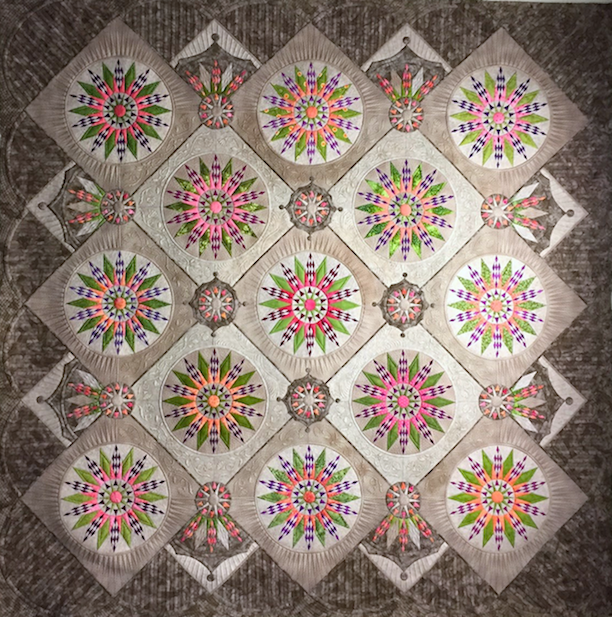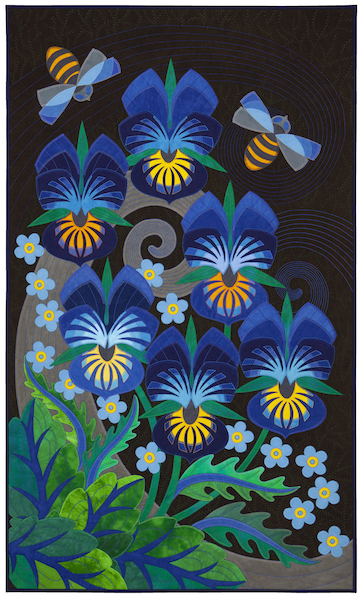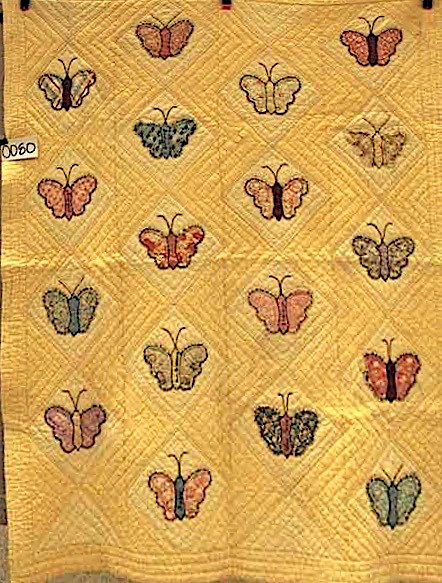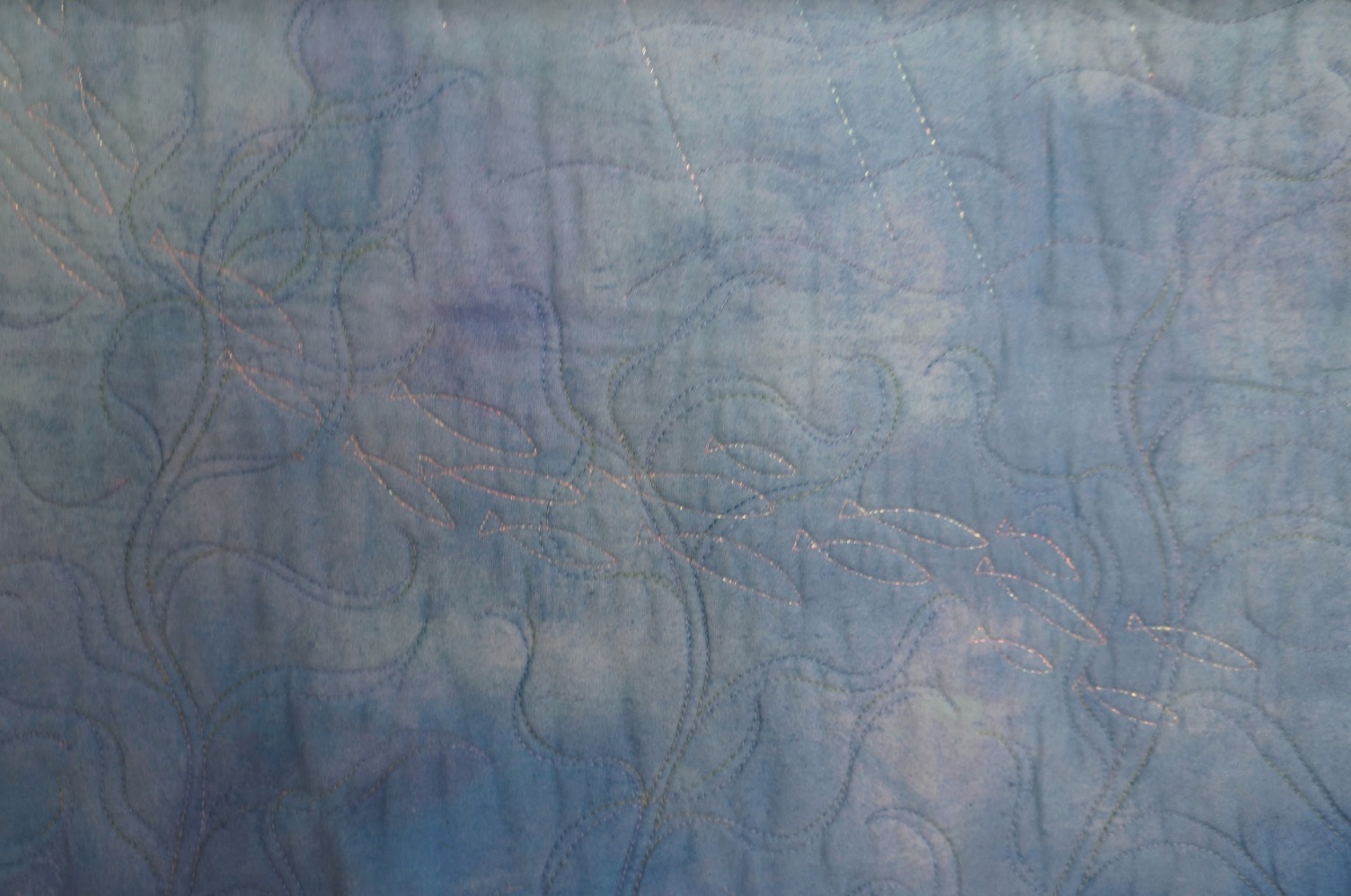 1
1
Three Easy Steps To Save This Lesson As A Pdf:
-Make sure you are logged in.
-Click on the small triangle next to the tool wheel in the upper right hand corner of the page (you'll find it above the Like button).
-Select the pdf. option. Wait a few minutes. It's a large file due to the number of images.
-Your file should appear with the title of the lesson.
It's time to check your answers to see how well you did on last week's quiz.
Rhythm / Movement - Lesson 39
Unity / Variety - Lesson 40, Lesson 41, and Lesson 42
Contrast - Lesson 43
Radial Balance - Lesson 30, Lesson 31, and Lesson 32
Pattern / Repetition - Lesson 35, Lesson 36, and Lesson 37
Emphasis - Lesson 38
Asymmetrical Balance - Lesson 32 and Lesson 33
Emphasis: A technique of shifting the viewers attention to what the artist finds to be most important.

Harmony by Cristina Arcenegui Bono (Image by AQS)
Radial Balance: A design where all of the elements are equally balanced, toward or away from a central point.

Summertime by Elsie Campbell. (Show 407). [Image Road2CA]
Rhythm and Movement: A design that draws you in while also taking you on a visual journey into, around, and across a quilt.

Celebrating Our Diversity by Carol Ann Waugh. (Show 1011). [Image courtesy of Carol Ann Waugh]
Contrast: A design that brings together the variety of elements (i.e. color, texture, form) to create a unique and visually interesting work for the viewer.

Autumn Antics by Ethelda Ellis and Sharon Moore. (Image TheQuiltShow.com)
Symmetrical Balance: The visual arrangement of elements (color, texture, space, etc.) to create a sense of stability and calm. A visual line can be drawn down the center of the quilt, resulting in a mirroring of the elements.

Cardinal Points by Gail Stepanek and Jan Hutchison. (Image TheQuiltShow.com)
Pattern/Repetition: Combining of elements or motif in an arranged and repeated manner
Ova Nova by Louisa Smith. (Show 204 and Show 1705). [Image TheQuiltShow.com]
Asymmetrical Balance: A design that is balanced, but with a more energetic and exciting feeling because the elements are not place in a symmetrical order.

Johnny Jump Ups by Jane Sassaman (Show 301). [Image TheQuiltShow.com].
Unity/Variety: Everyone in a group is playing together. Unity-Every unit is the same color/size. Variety-Units are a different size/color.

Log Lunacy by Cindy Seitz-Krug. (Show 2603). [Image QuiltCon].

You’re at the quilt shop, standing in front of rows and rows of fabric. Some bolts grab your eye immediately, begging for a closer inspection. Others, not so much. Whether the fabric speaks to you or not, there is a good chance most of that fabric in your local quilt shop is 100 percent cotton. And that cotton has been on a very, very long journey.


In fact, one tiny boll of cotton, from a seed in the ground, to a soft and strong fiber that is ultimately used to construct your favorite fabric, may have traipsed around the world two, three, maybe even four times before it lands on the shelf at your local store.
So, when you pick up that perfect fat quarter for a mere three bucks or so, consider this. Cotton is grown in some 80 countries. The cotton fibers inside your quarter-yard were most likely grown in China, India, Pakistan or the U.S., possibly even Texas, which is by far the largest producing state in the U.S. It’s also possible the cotton was grown in Brazil, Greece, or Australia.
The multi-billion-dollar quilt industry is one of the largest consumers of 100 percent cotton textiles. That is quite something to absorb. In the not too distant past, lots of things – clothing especially – were all made with pure cotton. But the evolution of technology has allowed countless combinations of synthetic textiles that enable clothes to be soft, strong, stretchy, structured, water/weather proof, etc. Not even blue jeans, which were once renowned for their use of cotton, are all cotton anymore. Instead, most jeans are now constructed with a blend of fibers and/or synthetics. That said, in the past few years some high-end blue jean manufacturers are returning to their roots and touting their “new” jeans made with pure cotton.

Today, quilting fabric stands nearly alone in the world of 100 percent cotton products. Only medical supplies and other specialty items are still made with cotton only. Quilters love cotton and have come to depend on its strength, its flexibility, the way it responds to sewing, the way it presses, and frankly among other reasons, its beauty.
The real beauty begins when a farmer, whether he’s tilling the savannahs of Brazil, plowing the plains of Texas, or turning the river basins of China, plants a seed in the ground. That seed grows into an ugly, squat little plant, and eventually, once a year, a beautiful boll of white cotton will emerge. Fields of white, often as far as the eye can see.
In the 1600’s, the Japanese poet Matsuo Basho wrote: “A field of cotton – as if the moon had flowered.”
Once cotton matures, it is harvested and begins the first leg of its journey to a cotton gin. Next, ginned raw cotton is packed into huge bales and the majority of those bales will be readied for export. They travel to one of the world’s prolific weaving and spinning mills. Back during the 19th century, the United Kingdom was the center of the textile world, then in the 20th century the United States became the dominant player. Today, Asia has taken over that title.


It’s almost impossible to pick up a bolt of fabric, or a garment, and distinguish where all that cotton is grown, even if we know where the base textile was made. Most often, huge bales of raw ginned cotton are spread across the spinning room floor and giant machines blend fibers of different strengths and staple lengths, creating a veritable cornucopia of fibers from every growing region around the globe. From there, a yarn is spun and a textile is formed.
For quilting cotton specifically, the fabric manufacturers most often employ textile printing mills located in Japan, Korea and China.
While researching my book, “Cotton & Indigo from Japan,” I focused on Japan and her textile printing mills. The most interesting, and perhaps confusing fact, is that for the majority of textiles printed in Japan, the base textile is not made in Japan. The base textile is most often imported from China, Pakistan, or India, or other Southeast Asian nations.


Japan began growing cotton 600 years ago. But today, this island nation no longer grows cotton on a large scale. Nonetheless, some base textiles are milled in Japan (with imported cotton) and occasionally Japanese fabric manufacturers will use these domestic textiles for special collections, or simply for high-end requirements. Yuwa Shoten and the ever popular Kokka both produce some fabrics where the textile is both made in Japan and printed in Japan. And this is important because it allows for total quality control over the entire process.
Regardless of the origin of the cotton or the base textile, Japan is considered the premier destination for printing the highest quality quilting fabric today.

For example, everyone loves Moda fabric, right? Interestingly, about 45 percent of all Moda fabric is printed in Japan, which accounts for the lovely finish and hand of many of Moda’s products. Cotton + Steel, another popular quilting cotton producer, prints 100% of their fabrics in Japan. The list goes on. Many fabric manufacturers make a conscious choice of Japan because they want the best quality the market can offer.
No matter whether the fabric is printed in Japan or elsewhere, after the manufacturer produces bolts and bolts of their new fabric collections, those bolts are wrapped up and once again, the cotton fibers begin making the second half of their worldwide journey.
A seed goes in the ground --- it might be planted in some far flung local, or in soil right in your own community. It travels to a gin. Then it travels to some port, where it is placed on a ship. It is imported by a mill and made into some form of a base textile. Then, off it goes again to a printing mill. Its printed and finished into a brand-new fabric. Then, its packed up again. Trekked across nations and oceans. Finally, trains and trucks get this worldly cargo delivered right to your local shop.
Quite a journey for a wonderous fiber.

Ricky sat down with author Teresa Duryea Wong while at the Houston Quilt Festival and discussed the different types of Japanese fabrics that can currently be found in today's quilts. You might be surprised, it isn't all taupe and gray.

Teresa Duryea Wong is a lifelong writer and communicator. She began her career as a journalist, and later published a fine art magazine. For two decades, she worked in public affairs and eventually became Vice President of Communications for a large corporation. She currently writes, quilts and blogs about quilts. Teresa holds a Master of Liberal Studies degree from Rice University and was recently named the 'Faith P. and Charles L. Bybee Foundation Scholar' by the Bybee Foundation and the Texas Quilt Museum.
Click here for more topics related to The Art of Quilt Design program
















































.jpg)


